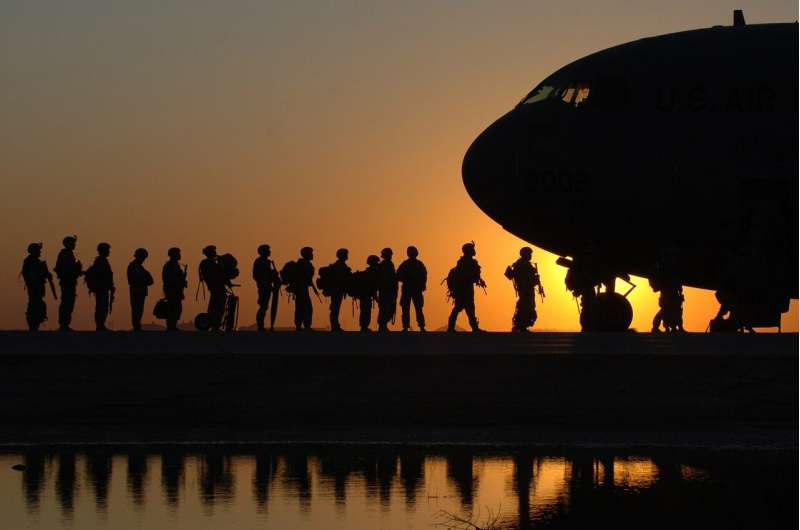Dramatic increases seen in rates of insomnia, sleep apnea among US military

Insomnia and obstructive sleep apnea have increased dramatically among active-duty military members over a 14-year period, 2005 through 2019.
Insomnia increased 45-fold and sleep apnea went up more than 30-fold, according to a study led by The University of Texas Health Science Center at San Antonio (UT Health San Antonio).
The study found that the most likely military member to be diagnosed with either sleep disorder was married, male, white, a higher-ranking enlisted Army service member and age 40 or older.
The researchers compared medical codes that represent diagnosis of sleep apnea or insomnia in active-duty Army, Navy, Marine Corps and Air Force personnel. No medical code data was available for the Coast Guard or for the Space Force, which was established in December 2019.
"Other studies have been conducted in the past, but those were based more on self-reported surveys or focused on a single branch of the military. No one has studied these sleep disorders in multiple branches of the military before, based on universally used diagnostic medical codes from health records," said principal investigator Vincent Mysliwiec, MD.
Dr. Mysliwiec is a sleep medicine physician and professor of research in the Department of Psychiatry and Behavioral Sciences at UT Health San Antonio, and a retired U.S. Army colonel.
"The most surprising result was that military members in the Army had the highest rates of obstructive sleep apnea and insomnia diagnoses. These findings are concerning because service members across the military branches are otherwise healthy and have similar physical requirements. Their sleep disorders developed and were diagnosed while they were in the military," Dr. Mysliwiec said.
Lower rate seen in women
Another finding was that women were diagnosed for sleep disorders at a much lower rate than men. Women in the military were expected to have lower rates of sleep apnea than their male counterparts; however, women in the military were not expected to have lower rates of insomnia diagnoses. "This conflicts with the rate of insomnia diagnoses among female veterans and in civilian women, which are higher," he said.
A 2017 Department of Veterans Affairs study published in Women's Health Issues showed that more than half of female veterans reported in a postal survey that they have insomnia. "We were not expecting to find that women are potentially underdiagnosed for insomnia while they are on active duty," Dr. Mysliwiec said. "This is a concerning finding. We will need to conduct more research to better understand what contributes to the potential underdiagnosis of insomnia in active-duty women."
Long deployments
Study co-author Alan Peterson, Ph.D., added perspective to the large number of Army personnel who were diagnosed with sleep disorders. "While military deployments were not evaluated in this epidemiological study, previous research has shown a strong correlation between deployments and sleep disorders, and deployments combined with other chronic health conditions, such as post-traumatic stress disorder and traumatic brain injury," he said.
"In the wars in Afghanistan and Iraq, there were longer and more frequent deployments between 2008 and 2012. The Army typically had the longest and most frequent deployments—21 months—compared to 12 to 16 months for the other services," he explained.
"While we don't know yet exactly why Army personnel were more likely to be diagnosed with obstructive sleep apnea or insomnia, another factor besides deployments could be that Army personnel have greater access to large medical centers, which are typically located on Army posts. In contrast, Marines rely on Navy medical facilities that may not be where they are serving," Dr. Peterson said.
"Another factor that could have influenced the results is that the Army was the first service to institute a service-wide education program on military sleep practices. Having greater access to medical facilities and the Army's emphasis on education about sleep disorders may have resulted in more soldiers recognizing their sleep disturbances and seeking appropriate treatment," Dr. Peterson said.
"Overall, this study provides a comprehensive overview of the two most common sleep disorders in the U.S. military and contributes to sleep research that opens the door to learning more about the causes for these diagnoses. This will lead to more targeted prevention strategies and more effective treatments," added Dr. Peterson, professor of psychiatry, chief of the Division of Behavioral Medicine and director of two national military PTSD research consortia based at UT Health San Antonio.
More information: Brian A Moore et al, Incidence of insomnia and obstructive sleep apnea in active duty United States military service members, Sleep (2021). DOI: 10.1093/sleep/zsab024



















